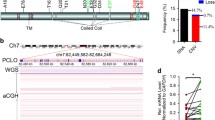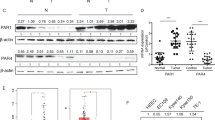Abstract
Background: The EGF receptor is a therapeutic target in cancer cells, whereby mutations of EGFR and/or signalling members act as predictive markers. EGFR however also exhibits dynamic changes of subcellular localization, leading to STAT5 complex formation, nuclear translocation and induction of Aurora-A expression in squamous cancer cells. We previously described high EGFR and Aurora-A expression in esophageal cancer cells. Here, we investigated subcellular localization of EGFR and STAT5 in esophageal cancer cells. Results: Quantitative immunofluorescence analyses of four esophageal cancer cell lines reflecting esophageal squamous cell carcinomas (ESCC) and esophageal adenocarcinomas (EAC) revealed that the subcellular localization of EGFR was shifted from a membranous to cytoplasmic localization upon EGF-stimulation in OE21 (ESCC) cells. Thereby, EGFR in part co-localized with E-Cadherin. In parallel, phosphorylated STAT5-Tyr694 appeared to increase in the nucleus and to decrease at the cell membrane. In three additional cell lines, EGFR was only marginally (Kyse-410/ESCC; OE19/EAC) and weakly (OE33, EAC) detectable at the cell membrane. Partial co-localization of EGFR and E-Cadherin occurred in OE33 cells. Post EGF-stimulation, EGFR was detected in the cytoplasm, resembling endosomal compartments. Furthermore, OE19 and OE33 exhibited nuclear STAT5-Tyr694 phosphorylation upon EGF-stimulation. None of the four cell lines showed nuclear EGFR expression and localization. Conclusion: In contrast to other (squamous) cancer cells, activation of EGFR in esophageal squamous cancer cells does not result in nuclear translocation of EGFR. Still, the subcellular localization of EGFR may influence STAT5-associated signaling pathways in esophageal cancer cells and hence possibly also the responses to ErbB, respective EGFR-targeted therapies.




Similar content being viewed by others
Abbreviations
- EAC:
-
Esophageal Adenocarcinoma
- EGF:
-
Epidermal Growth Factor
- EGFR:
-
Epidermal Growth Factor Receptor
- ESCC:
-
Esophageal Squamous Cell Carcinoma
- PBS:
-
Phosphate buffered saline
- STAT:
-
Signal Transducer and Activator of Transcription
References
Ahrens TD, Timme S, Hoeppner J, Ostendorp J, Hembach S, Follo M, Hopt UT, Werner M, Busch H, Boerries M, Lassmann S (2015) Selective inhibition of esophageal cancer cells by combination of HDAC inhibitors and azacytidine. Epigenetics:. doi:10.1080/15592294.2015.1039216
Aichler M, Motschmann M, Jütting U, Luber B, Becker K, Ott K, Lordick F, Langer R, Feith M, Siewert JR, Walch A (2014) Epidermal growth factor receptor (EGFR) is an independent adverse prognostic factor in esophageal adenocarcinoma patients treated with cisplatin-based neoadjuvant chemotherapy. Oncotarget 5(16):6620–6632
Alvarez JV, Frank DA (2004) Genome-wide analysis of STAT target genes: elucidating the mechanism of STAT-mediated oncogenesis. Cancer Biol Ther 3(11):1045–1050
Burke P, Schooler K, Wiley HS (2001) Regulation of Epidermal Growth Factor Receptor Signaling by Endocytosis and Intracellular Trafficking. Mol Biol Cell 12(6):1897–1910
Cronin J, McAdam E, Danikas A, Tselepis C, Griffiths P, Baxter J, Thomas L, Manson J, Jenkins G (2011) Epidermal growth factor receptor (EGFR) is overexpressed in high-grade dysplasia and adenocarcinoma of the esophagus and may represent a biomarker of histological progression in Barrett’s esophagus (BE). Am J Gastroenterol 106(1):46–56. doi:10.1038/ajg.2010.433
Enzinger PC, Mayer RJ (2003) Esophageal cancer. N Engl J Med 349(23):2241–2252. doi:10.1056/NEJMra035010
Fichter CD, Herz C, Münch C, Opitz OG, Werner M, Lassmann S (2011) Occurrence of multipolar mitoses and association with aurora-a/−B kinases and p53 mutations in aneuploid esophageal carcinoma cells. BMC Cell Biol 12:13. doi:10.1186/1471-2121-12-13
Fichter CD, Timme S, Braun JA, Gudernatsch V, Schöpflin A, Bogatyreva L, Geddert H, Faller G, Klimstra D, Tang L, Hauschke D, Werner M (2014a) Lassmann S (2014) EGFR, HER2 and HER3 dimerization patterns guide targeted inhibition in two histotypes of esophageal cancer. Int J Cancer 135(7):1517–1530. doi:10.1002/ijc.28771
Fichter CD, Gudernatsch V, Przypadlo CM, Follo M, Schmidt G, Werner M, Lassmann S (2014b) ErbB targeting inhibitors repress cell migration of esophageal squamous cell carcinoma and adenocarcinoma cells by distinct signaling pathways. J Mol Med (Berl) 92(11):1209–1223. doi:10.1007/s00109-014-1187-5
Hadzisejdić I, Mustać E, Jonjić N, Petković M, Grahovac B (2010) Nuclear EGFR in ductal invasive breast cancer: correlation with cyclin-D1 and prognosis. Mod Pathol 23(3):392–403. doi:10.1038/modpathol.2009.166
Hoshino M, Fukui H, Ono Y, Sekikawa A, Ichikawa K, Tomita S, Imai Y, Imura J, Hiraishi H, Fujimori T (2007) Nuclear expression of phosphorylated EGFR is associated with poor prognosis of patients with esophageal squamous cell carcinoma. Pathobiology 74(1):15–21. doi:10.1159/000101047
Hung L, Tseng JT, Lee Y, Xia W, Wang Y, Wu M, Chuang Y, Lai C, Chang W (2008) Nuclear epidermal growth factor receptor (EGFR) interacts with signal transducer and activator of transcription 5 (STAT5) in activating aurora-a gene expression. Nucleic Acids Res 36(13):4337–4351. doi:10.1093/nar/gkn417
Kato H, Arao T, Matsumoto K, Fujita Y, Kimura H, Hayashi H, Nishiki K, Iwama M, Shiraishi O, Yasuda A, Shinkai M, Imano M, Imamoto H, Yasuda T, Okuno K, Shiozaki H, Nishio K (2013) Gene amplification of EGFR, HER2, FGFR2 and MET in esophageal squamous cell carcinoma. Int J Oncol 42(4):1151–1158. doi:10.3892/ijo.2013.1830
Ku GY, Ilson DH (2013) Emerging tyrosine kinase inhibitors for esophageal cancer. Expert Opin Emerg Drugs 18(2):219–230. doi:10.1517/14728214.2013.805203
Linggi B, Carpenter G (2006) ErbB receptors: new insights on mechanisms and biology. Trends Cell Biol 16(12):649–656. doi:10.1016/j.tcb.2006.10.008
Lorenzen S, Riera Knorrenschild J, Haag G, Pohl M, Thuss-Patience P, Bassermann F, Helbig U, Weißinger F, Schnoy E, Becker K, Stocker G, Rüschoff J, Eisenmenger A, Karapanagiotou-Schenkel I, Lordick F (2015) Lapatinib versus lapatinib plus capecitabine as second-line treatment in human epidermal growth factor receptor 2-amplified metastatic gastro-oesophageal cancer: a randomised phase II trial of the arbeitsgemeinschaft internistische onkologie. Eur J Cancer 51(5):569–576. doi:10.1016/j.ejca.2015.01.059
Marx AH, Zielinski M, Kowitz C, Dancau A, Thieltges S, Simon R, Choschzick M, Yekebas E, Kaifi JT, Mirlacher M, Atanackovic D, Brümmendorf TH, Fiedler W, Bokemeyer C, Izbicki JR, Sauter G (2010) Homogeneous EGFR amplification defines a subset of aggressive Barrett’s adenocarcinomas with poor prognosis. Histopathology 57(3):418–426. doi:10.1111/j.1365-2559.2010.03643.x
Mirmohammadsadegh A, Hassan M, Bardenheuer W, Marini A, Gustrau A, Nambiar S, Tannapfel A, Bojar H, Ruzicka T, Hengge UR (2006) STAT5 phosphorylation in malignant melanoma is important for survival and is mediated through SRC and JAK1 kinases. J Investig Dermatol 126(10):2272–2280. doi:10.1038/sj.jid.5700385
Quesnelle KM, Boehm AL, Grandis JR (2007) STAT-mediated EGFR signaling in cancer. J Cell Biochem 102(2):311–319. doi:10.1002/jcb.21475
Timme S, Ihde S, Fichter CD, Waehle V, Bogatyreva L, Atanasov K, Kohler I, Schöpflin A, Geddert H, Faller G, Klimstra D, Tang L, Reinheckel T, Hauschke D, Busch H, Boerries M, Werner M, Lassmann S (2013) STAT3 expression, activity and functional consequences of STAT3 inhibition in esophageal squamous cell carcinomas and Barrett’s adenocarcinomas. Oncogene 33(25):3256–3266. doi:10.1038/onc.2013.298
Vieira AV, Lamaze C, Schmid SL (1996) Control of EGF receptor signaling by clathrin-mediated endocytosis. Science 274(5295):2086–2089
Wang S, Hung M (2009) Nuclear translocation of the epidermal growth factor receptor family membrane tyrosine kinase receptors. Clin Cancer Res 15(21):6484–6489. doi:10.1158/1078-0432.CCR-08-2813
Wang Y, Hung M (2012) Nuclear functions and subcellular trafficking mechanisms of the epidermal growth factor receptor family. Cell Biosci 2(1):13. doi:10.1186/2045-3701-2-13
Wang Y, Yamaguchi H, Hsu J, Hung M (2010) Nuclear trafficking of the epidermal growth factor receptor family membrane proteins. Oncogene 29(28):3997–4006. doi:10.1038/onc.2010.157
Xia W, Wei Y, Du Y, Liu J, Chang B, Yu Y, Huo L, Miller S, Hung M (2009) Nuclear expression of epidermal growth factor receptor is a novel prognostic value in patients with ovarian cancer. Mol Carcinog 48(7):610–617. doi:10.1002/mc.20504
Acknowledgments
The authors acknowledge technical support of Ms. Anja Schoepflin and Ms. Nicola Bittermann as well as proofreading of the manuscript by K. Schneider. The study was supported by the Deutsche Forschungsgemeinschaft (SFB850 grant C5 to SL, MW) and in part by the Mushett Family Foundation (Chester, NJ, USA; grant to SL, MW).
Authors contributions
LS, CF: Performed and analyzed experiments, wrote manuscript; MW: contributed morpho−/cytological interpretation, discussed results, approved manuscript, provided resources; SL: Designed study, analyzed data, wrote manuscript, provided resources.
Author information
Authors and Affiliations
Corresponding author
Ethics declarations
Competing interests
The author(s) declare that they have no competing interests.
Rights and permissions
About this article
Cite this article
Spohn, L., Fichter, C., Werner, M. et al. Subcellular localization of EGFR in esophageal carcinoma cell lines. J. Cell Commun. Signal. 10, 41–47 (2016). https://doi.org/10.1007/s12079-015-0308-4
Received:
Accepted:
Published:
Issue Date:
DOI: https://doi.org/10.1007/s12079-015-0308-4




